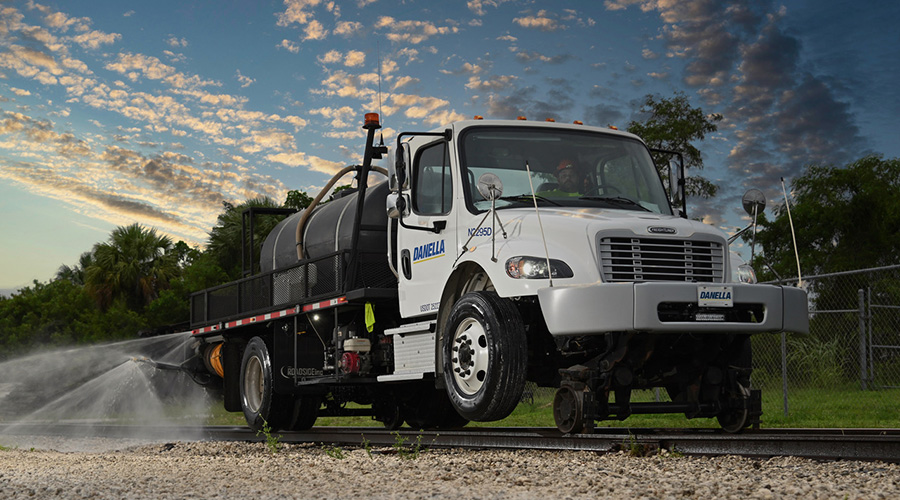Stay updated on news, articles and information for the rail industry
September 2021
Rail News: MOW
Product update: Rail lubricants and friction modifiers 2021
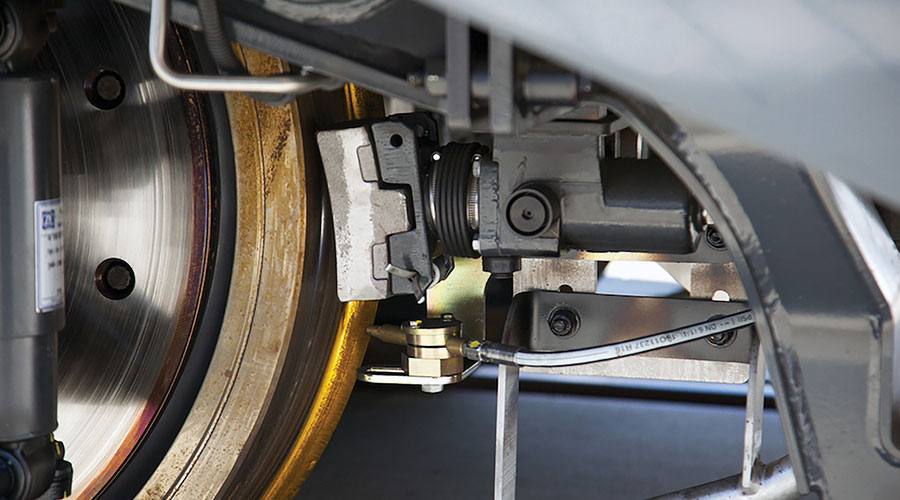
Compiled By Michael Popke
Klüber Lubrication
Rail-car wheel flanges and rail contact zones are subject to high forces when going through bends and around curves — leading to wear and noise if lubrication is insufficient.
Klüberrail ALE 92-2000, Klüberrail LEA 62-2000 (wheel flange), Klüberrail AE 62-21 and Klüberrail 12-141 (U.S. trackside) were developed as eco-compatible, fully synthetic specialty lubricants for wheel flanges and curves. Biodegradable according to OECD 301 F standards, the fluids consist of a synthetic base oil, a mixed thickener and a combination of selected solid lubricants, Klüber Lubrication officials said in an email.
Additives used in Klüberrail ALE 92-2000 and Klüberrail ALE 62-200 are formulated to ensure strong adhesion to the wheel flange, so the lubricant is not flung off, even at high speeds. They also are water resistant and do not typically wash off when it rains, company officials said.
L.B. Foster Co.
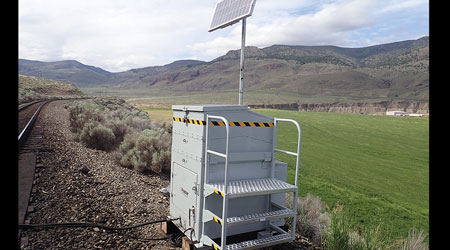
L.B. Foster Co. focuses on helping freight and transit customers maximize existing friction management programs by continually improving equipment, consumables and performance monitoring services. The aim: “to ensure programs are working at peak efficiency and to eliminate failure potential,” company officials said in an email.
Within the past year, the company launched its next generation Remote Performance Monitoring (RPM) 2.0 platform to provide freight customers real-time insight into the performance of each of their trackside lubricators with a more user-friendly interface. The RPM 2.0 platform allows customers to continually analyze and compile telemetry taken from existing GPS-enabled trackside units to determine and track friction management program uptime, as well as update unit locations via GPS, company officials said.
L.B. Foster also introduced the trackside PROTECTOR® X friction management system. One key feature is an enhanced product compartment design, which provides a first-in, first-out product utilization system to minimize known issues when switching between seasonal greases. The system also minimizes cavitation, and its enlarged capacity allows for longer intervals between tank refills.
On the transit side, L.B. Foster is conducting field trials for its new top-of-rail (TOR) product, KELTRACK® Transit EX. The premium, all-season TOR friction modifier provides extended carry-down capabilities at all operating temperatures while continuing to provide protection in the wheel/rail interface, company officials said. KELTRACK Transit EX has been specifically designed with enhanced film durability, improved corrosion resistance and a low freezing point.
Loram Technologies Inc.
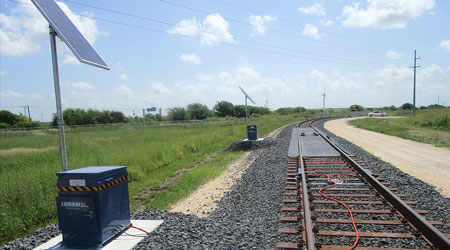
Adverse wheel and rail interaction pose one of the biggest threats to the life and performance of rail and rolling assets. Loram Technologies Inc. offers gauge face and top-of-rail (TOR) consumables in biodegradable, synthetic and water-based versions.
Loram’s gauge face lubricants are designed for transit or heavy-haul applications, pumpable in very low temperatures and biodegradable. EcoCurve Heavy Haul is readily biodegradable, carries the European Ecolabel and is suitable to use near bodies of water. EcoCurve Trackside is also readily biodegradable and is widely used in the transit market worldwide, company officials said in an email. Rail King HL is “inherently biodegradable” and has high load carrying additives, making it best suited for heavy-haul applications, they added.
The company’s TOR friction modifiers are specifically designed for wayside applications, help reduce noise, extend rail and wheel life, and contribute to fuel savings, Loram officials said. TOR-XTend is a clean synthetic friction modifier with a low evaporation rate, uses less material per application than similar products and has a carry distance of over six miles in most applications, company officials said. TOR-H₂0X, meanwhile, has the benefits of both water-based and synthetic-based modifiers and is a non-cavitating material with a carry distance of four to six miles.
Loram’s 25-gallon solar- or AC-powered trackside tank is the company’s newest application system. Easy to maintain and install, it is designed for use in low-traffic areas such as switching yards and industrial spurs, and can handle lower tonnage Class Is and transit systems.
Railmark Track Works Inc.
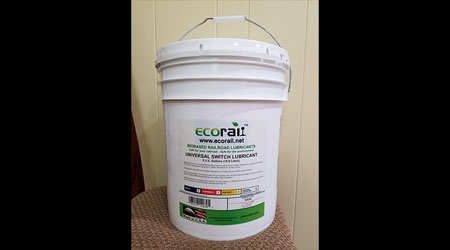
Since 2012, Railmark Track Works Inc. has provided biobased rail lubricants to industrial rail users, railroads and transit agencies. The company offers its ECORail™ line of branded biobased rail lubricants with superior lubricity and reduced friction, which ultimately translates to less heat and less wear, company officials said in an email.
Railmark’s ECORail biobased lubricants include Biobased/Biodegradable Rail Curve Greases, Biobased/Biodegradable Top of Rail Compounds, Biobased/Biodegradable Universal Switch Lubricants, and Biobased Hydraulic Oils. The line of lubricants meets the U.S. Environmental Protection Agency’s environmental preferable purchasing criteria and is designated a USDA BioPreferred™ product. ECORail biobased lubricants work well in all known applicators, company officials said.
Manufactured in the United States from renewable crop-based oils with a lithium-based thickener, the ECORail lubricants are safe for rail employees, the public and the environment because they contain no heavy metals, chlorine or harsh odors, Railmark officials said. The lubricants have viscosity indices that are twice as high (over 200) as equivalent viscosity petroleum-based oils, providing more stable viscosity at different temperatures and a wider range of operation, they said.
Due to their polarity, biobased molecules bond and adhere to metal surfaces better than petroleum-based oils and greases, and they have a higher flash point than mineral greases to help increase safety, company officials said.
Railmark also offers friction management programs for railroads and transit agencies. Scheduled inspections, maintenance, lubricator installations and complete turn-key lubrication packages are available that include both equipment and ongoing servicing.
Industry-Railway Suppliers Inc.
Industry-Railway Suppliers Inc. is the exclusive U.S. distributor of Slip Plate’s OEM-8 lubricant, company officials said in an email. Designed to provide superior friction control, the dry-film, graphite-based lubricant is environmentally safe and suited for switch plates/switch points, which handle some of the highest forces on track, and require frequent maintenance and smooth transitions.
The tough, graphite formulation of the OEM-8 creates a “slick, hydrophobic, non-stick surface” designed to extend switch life, company officials said. The graphite powders in the OEM-8 allow the lubricant to dry quickly without dripping, and aren’t affected by extreme cold or heat, they said. The lubricant also is available in an aerosol, making it convenient for use on switch arms.
Michael Popke is a Madison, Wisconsin-based freelance writer. Email comments or questions to prograil@tradepress.com.


 2025 MOW Spending Report: Passenger-rail programs
2025 MOW Spending Report: Passenger-rail programs
 Gardner steps down as Amtrak CEO
Gardner steps down as Amtrak CEO
 Guest comment: Oliver Wyman’s David Hunt
Guest comment: Oliver Wyman’s David Hunt
 Women of Influence in Rail eBook
Women of Influence in Rail eBook
 railPrime
railPrime





